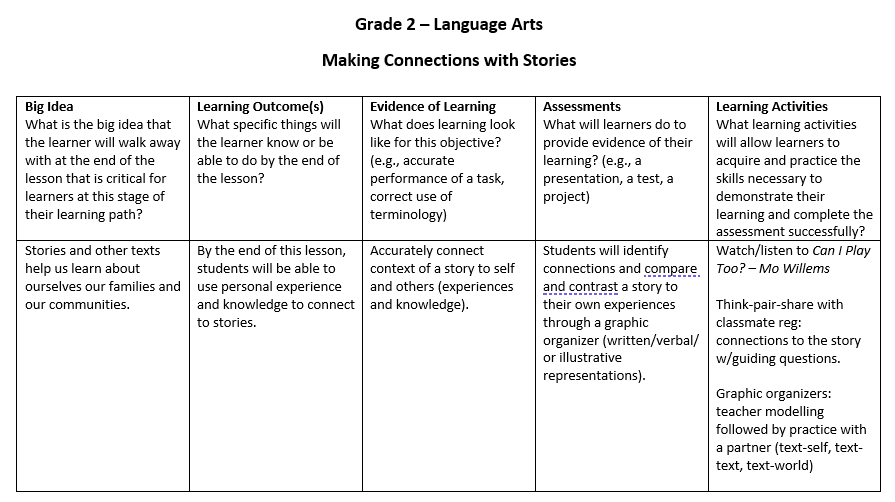Creating effective, engaging, and meaningful lessons for learners can be a challenge. This week we learned about principles and practices of instructional design such as constructive alignment and backwards design, that will support us in creating learning opportunities that go beyond rote memorization and ‘busy’ work for our learners. Below, I created a grade 2 ELA lesson on using stories to connect with ourselves and others – using the constructive alignment template provided. I wanted to take this one step further and utilize Merill’s five principles of instructional design to the same lesson to see how I could strengthen the lesson content to engage my learners to solve authentic problems (2002).
Example of Constructive Alignment:
| Big Idea | Learning Outcome | Evidence of Learning | Assessment | Learning Activities |
| Aligned and coherent learning design promotes constructivist learning | By the end of this week you will be able to: Recognize misalignment in outcomes, assessment and activities in a lesson design | An accurate example of alignment or misalignment in a lesson design | -A blog post demonstrating use of a planning template and reflecting on process-A comment on another post | -Watch video demonstration of alignment and misalignment and discuss with Learning Pod-Practice using a planning template |
My ELA lesson

Big Idea and learning outcomes retrieved from BC Curriculum – Grade 2 ELA
Merrill’s Five Principles applied to this lesson:
- Learners are engaged in solving real-world problems
- The real-world problem in this case is ‘how to make our classroom more inclusive’ or more specifically, ‘how to make x activity more inclusive in our classroom’.
- Start lesson by providing an overview of what we will be learning.
- Existing knowledge is activated as a foundation for new knowledge
- Prior knowledge activation. Class discussion/writing ideas on the board –what does it mean to be included/left out?
- Followed by watching a read aloud of Can I Play Too? by Mo Willems.
- New knowledge is demonstrated to the learner
- Watch this video on Ways to Teach Kids about Inclusion
- Model how to complete a simple graphic organizer
- focus on identifying and implementing specific things that you can do in your classroom to make it more inclusive (e.g., removing a physical barrier such as books that are too high for smaller students to reach or allowing more time for transitioning to new activities, or rotating partners rather than having people choose etc.). They need to learn the emotional intelligence piece but also how structural changes can support those behaviours.
- New knowledge is applied by the learner
- Play a game- provide scenarios of good and bad problem-solving, fairness, and relationship skills in a classroom setting and have students raise their hands according to whether they believe it was a good or a bad way to include others/be fair.
- Think-pair-share – have you ever been left out or seen someone left out? how did that feel? what could be done to help everyone feel included?
- New knowledge is integrated into the learner’s world
- Creation of graphic organizer (“Story reminds me of/makes me think of?”)
How did I feel about using Merrill’s principles to guide my lesson?
Honestly, I struggled with this and see many inconsistencies with this lesson. I understand the effectiveness of utilizing design principles to guide lesson creation but I found it difficult to implement with young learners, without it feeling like a stretch. I feel that I need more experience with this process in order to create effective learning experiences that are engaging, meaningful, and help students apply their knowledge to new situations.
The look of boredom I hope to prevent during my lessons!

Gif of Bart Simpson looking bored, retrieved from giphy.
Resources:
Merrill, M. D. (2002). First Principles of Instruction. ETR&D, 50, 3. pp. 43-59.

Hi Sarah,
I agree with you that Merrill’s principle is more complex than it seems to use to design a lesson plan. You need to know what pre-existing knowledge positively correlates and can be used as foundation to what you are teaching to put into action. You need to know how that pre-existing knowledge and the new concepts you as a teacher are about to teach can be used in real-life situations. I feel like to design a good lesson plan using Merrill’s principle takes a lot of experience and trial and error through creating those lesson plans. If this is the case, would this have an adverse effect of teaching poorly when you do not properly utilize Merrill’s principle? For example, what if I am teaching how to bake but I am not using the proper pre-existing knowledge of the learner properly as a foundation. Would this make it harder for the learner ultimately leading to a worst learning experience?
Thank you for the insight on that!
Also I really liked your chart. It shows a very in-depth backwards design at work that aligns the outcomes, assessments, and activities.
Thanks,
Becky Zeng